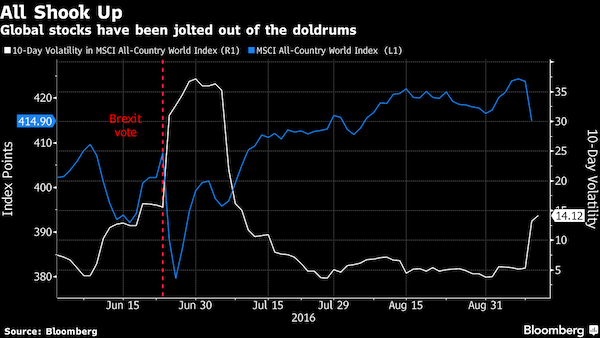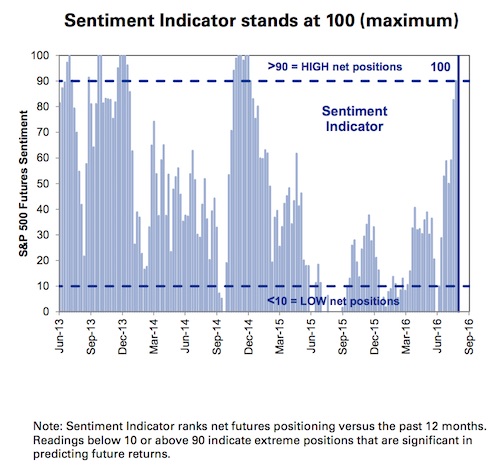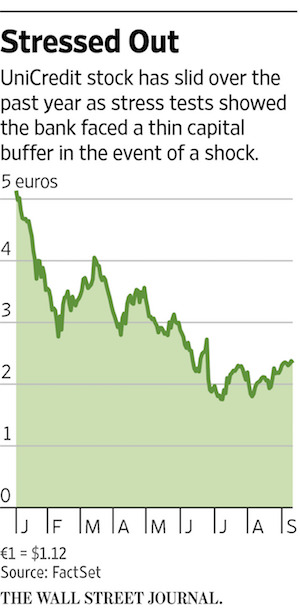
Harris&Ewing WSS (War Savings Stamps) poster, Washington DC 1917

Markets are in for a huge US election shock. An apt question Mish asked: what was she doing running around in public with a potentially highly contagious disease? More on this later.
• Clinton Health Another Landmine for Suddenly Vulnerable Markets (BBG)
Investors nursing wounds after the worst selloff in three months for equity and debt markets got another stress to ponder after concerns over Hillary Clinton’s health flared anew. The 68-year-old Democratic presidential nominee, whose polling edge over Donald Trump has soothed traders who fear ruptures to U.S. policy and see virtue in political gridlock, is suffering from pneumonia and became overheated and dehydrated during a Sept. 11 commemoration Sunday, forcing her to leave abruptly, her doctor said. Clinton was prescribed antibiotics and advised to modify her schedule so she can rest.
Volatility is already resurfacing in markets that had purred along for two months inured to everything from politics to weakening global growth, with the S&P 500 Index getting jarred Friday out of its tightest trading range ever in a selloff that erased about $500 billion of share value. While investors and analysts were reluctant to speculate on Clinton’s health, they said expectations she will prevail in November have been a factor in the calm and predicted the scrutiny will intensify. “If we found out that there was something catastrophic about her health it obviously would matter, but you have to be very careful about extrapolating shorter-term news,” Jonathan Golub at RBC Capital Markets in New York, said by phone.
“What we do know is we have two candidates around 70 years old and in reality it must be brutal running around the world for two years.” Speculation central banks are losing their taste for extra stimulus on Friday tore through the blanket of tranquility that has enveloped global markets. The S&P 500, global equities and emerging-market assets tumbled at least 2 percent in the biggest drop since Britain voted to secede from the European Union. The yield on the 10-year Treasury note jumped to the highest since June and the dollar almost erased a weekly slide.

It’s Brainard day. From Friday: “..investors recoiled over news that the central bank’s most dovish official, Governor Lael Brainard, will be delivering a previously unannounced speech Monday..”
• Asia Stocks, Bonds Sell-Off In Central Bank Anxiety Attack (R.)
Asian shares suffered their sharpest setback since June on Monday as investors were rattled by rising bond yields and talk the Federal Reserve might be serious about lifting U.S. interest rates as early as next week. Reports that the Bank of Japan was considering ways to steepen the Japanese yield curve, along with worries that central banks more generally were running short of fresh stimulus options, also hit sovereign debt and risk appetite globally. MSCI’s broadest index of Asia-Pacific shares outside Japan fell 2.4%, pulling away from a 13-month peak. It was the largest daily drop since the frenzy caused by Britain’s vote in late June to leave the European Union. On a technical basis the index had been overbought in recent sessions, leaving it vulnerable to a pullback.
Shanghai followed with a fall of 2%, while Australian stocks sank 2.2%. The Nikkei 225 lost 1.9% as the safe haven yen firmed and selling in bonds drove yields on 20-year JGBs to the highest since March. Traders were unsure how the BOJ would try to steepen the yield curve if it goes down that path at a policy review later this month, but markets are worried that tapering of its buying in long-dated bonds could be among the options. EMini futures for the S&P 500, traded in Chicago during Asian hours, swung 0.6% lower, though Treasuries were finding safe-haven demand. Some Fed members have been trying to convince markets that the September meeting would be “live” for a hike, even though futures only imply a one-in-four chance of a move.
No less than three Fed officials are expected to speak later in the day, including board member and noted dove Lael Brainard. Any hint of hawkishness would likely further pressure bonds and equities.

Angst alright.
• Global Stocks Sink With Bonds, Commodities as Fed Angst Builds (BBG)
Global selloffs in stocks and bonds resumed Monday, while commodities slumped amid concern central banks in the world’s biggest economies are questioning the benefits of loose monetary policy. Shares in Europe and Asia dropped by the most since the aftermath of Brexit, and futures foreshadowed declines in U.S. equities. Portugese debt led losses among euro-area bonds, while yields in Australia and New Zealand climbed to their highest levels of the quarter. Oil sank to about $45 a barrel as nickel tumbled the most in four weeks. The yen strengthened and South Korea’s won tumbled. Financial markets have been jolted out of a period of calm by an uptick in concern over the outlook for central bank policies.
Federal Reserve Bank of Boston President Eric Rosengren spurred bets on an interest-rate hike on Friday, saying the U.S. economy could overheat should policy makers wait too long to tighten. The comments came a day after European Central Bank chief Mario Draghi surprised markets by playing down the prospect of further stimulus. The S&P 500 slumped 2.5% Friday, breaking out of a range that hadn’t seen it move more than 1% in either direction for 43 days. “Central banks are reluctant to add additional stimulus and that’s causing a lot of concern,” Niv Dagan, executive director at Peak Asset Management in Melbourne, told Bloomberg Radio. “We expect additional downside in the near term. You want to wait and see and remain cautious,” he said.


“..I wouldn’t be surprised that we see some kind of repeat as we had towards the end of last year into January-February, which was something close to a 12% correction.”
• A ‘Perfect Storm’ In Stocks Is Coming, And Nothing Can Stop It (CNBC)
A sharp stock market pullback is imminent, according to David Rosenberg, chief economist and strategist at Gluskin Sheff. On Friday, stocks were hammered by fears the Federal Reserve might hike rates sooner than expected, sending the S&P 500 index and the Dow Jones industrial average into a tailspin. According to Rosenberg, there’s more trouble ahead. “You have a perfect storm here if you get something like a Fed rate hike into the next several months,” Rosenberg said Thursday on CNBC’s “Futures Now. “The problem is that the market is not priced for it. I wouldn’t be surprised that we see some kind of repeat as we had towards the end of last year into January-February, which was something close to a 12% correction.”
Rosenberg, who has been named to the U.S. Institutional Investor All-America All Star Team several times in his career, doesn’t think the shake-up can be avoided. His reasoning doesn’t just include a potential Fed rate hike. He also takes into account a more richly valued stock market, signs of investor complacency and a sluggish U.S. economy. “We entered into the third quarter with momentum and a lot of hope, and now we’re exiting the third quarter,” he said. “And, let’s face it: The last five or six [economic] numbers have been really soft,” he contended. “The problem now, looking at where the market is priced, you’ve got cycle high multiples, you’ve got a lot of hedge funds in the futures options market that have been chasing performance here up to the price highs, and it doesn’t take much in the way of any sort of near-term adverse news to cause the market to correct.”

“Where to Invest Now: None of the Above.”
• Goldman: We’ve Reached ‘Maximum’ Bullishness; Bad News for US Stocks (BBG)
U.S. stocks have climbed many walls of worry as they marched to fresh all-time highs in 2016. But the market calm that characterized the summer also propelled investor enthusiasm to extremely elevated levels, according to Goldman Sachs Group Inc., which bodes ill for the near-term performance of equities. Goldman’s sentiment indicator, which tracks S&P 500 futures positioning, now stands at 100 – its maximum level. Readings above 90 or below 10 are contrarian indicators that are “significant in predicting future returns,” writes Chief U.S. Equity Strategist David Kostin in a note titled “Where to Invest Now: None of the Above.” This degree of enthusiasm “points to a 2% near-term S&P 500 fall,” he said.


AKA: After central banks fail, governments have a go. But they are equally clueless.
• Governments May Boost Fiscal Stimulus As Central Banks Step Back (CNBC)
Central banks have done bulk of the heavy lifting to boost growth since the global financial crisis, but economists now were expecting fiscal spending will get some life. Analysts and central bankers alike have talked up the benefits recently of letting the sun shine in on government spending after years of an austerity drumbeat amid an anaemic global recovery from the financial crisis. “Numerous central bankers, including Mario Draghi, have stressed that monetary policy alone cannot get the world out of its current malaise,” noted Andrew Kenningham, senior global economist at Capital Economics, in a note Wednesday.
“The U.S. Treasury Secretary, Jacob Lew, even claimed ahead of the G-20 summit in China last weekend that the U.S. had won the argument in favour of ‘growth rather than austerity’ and that this had prompted a policy shift by many G-20 governments.” That was in part due to the effects of long-running easing efforts by central banks, Kenningham noted. Many sovereigns have seen their bond yields turn negative, while smaller government budget deficits have reduced debt sustainability concerns, he said. “With global growth still lacklustre, monetary policy seemingly ineffective and government bond yields unprecedentedly low, the case for fiscal stimulus has become more compelling,” Kenningham said. “Partly as a result, we now expect advanced economies overall to benefit from a small fiscal boost in the next couple of years.”

Oil is no longer an industry, it’s a gambling den.
• Oil Prices Fall As US Drillers Add New Rigs, Long Positions Are Cut (R.)
Crude prices fell over 1.5% on Monday after U.S. oil drillers added rigs to look for new production as producers adapt to cheaper crude, with speculators cutting positions betting on further price rises. Brent crude futures were trading at $47.29 per barrel at 0200 GMT (10:00 p.m. EDT), down 72 cents, or 1.5%, from their last settlement. U.S. West Texas Intermediate futures were down 80 cents, or 1.74%, at $45.08 a barrel. Traders said the price falls on Monday and Friday were a result of increasing oil drilling activity in the United States, which indicated that producers can operate profitably around current levels.
“Each dollar is being used far more efficiently and, as a result, $50 oil appears much more palatable,” Barclays bank said in a note to clients. U.S. drillers added oil rigs for a tenth week in the past 11, according to a Baker Hughes rig count report on Friday. It was the longest streak without rig cuts since 2011. Speculative oil traders also became less confident of higher oil prices, cutting their net long U.S. crude futures and options positions for a second consecutive week last week, the U.S. Commodity Futures Trading Commission (CFTC) said on Friday. Oil’s near 5%price decline since Sept. 8 partly reverses a 10% rally early in the month, which was fueled by speculation that oil exporters could cap production.

“Monte dei Paschi presented a plan in July to sell €28 billion of bad loans at 27% of face value. That has effectively set a new benchmark for the pricing of Italian bad loans..” But UniCredit expects to lose just 10%? Since UniCredit attributes a higher value to its bad loans, a sale of €20 billion of loans would force it to take €2 billion in write-downs…
• Woes at Italy’s Biggest Bank Reverberate in Europe (WSJ)
For UniCredit, the summer of discontent for Italy’s banks looks likely to stretch well into the fall—and possibly beyond. UniCredit, Italy’s largest lender by assets, emerged as one of the weakest big banks in Europe in July’s stress tests, showcasing the failure of its attempts to respond to rock-bottom interest rates and a huge pile of bad loans. Now, as Jean-Pierre Mustier, the bank’s new CEO, readies a big-bang plan to revive UniCredit’s fortunes, he faces a series of unpalatable choices: Aggressive action to cut the bank’s €80 billion ($89.9 billion) in bad loans—the largest of any European bank—would force the Milanese bank to raise billions in fresh capital, while an asset sale could help bolster its capital position but would hurt already thin profit.
Meanwhile, the travails of Italy’s No. 3 lender, Banca Monte dei Paschi di Siena, promise to only complicate Mr. Mustier’s job. On Thursday, Monte dei Paschi said its CEO, Fabrizio Viola, had agreed with the bank’s board to resign, in a surprise move that came as that bank works on a plan to shed €28 billion in bad loans. Troubles at UniCredit, which has a vast business in Germany and Eastern Europe, could threaten not only Italy’s ailing economy but also the continent’s already fragile financial stability. Brexit has upended Europe’s status quo, making the financial system more sensitive to shocks. Investors are watching UniCredit closely, as they expect its fate to affect both Italy and potentially other lenders on the continent.
[..] A major move to unload bad loans, perhaps as much as €20 billion, “will be key for a rerating of the stock,” said Vicenzo Longo at IG Markets. However, Monte dei Paschi presented a plan in July to sell €28 billion of bad loans at 27% of face value. That has effectively set a new benchmark for the pricing of Italian bad loans. Since UniCredit attributes a higher value to its bad loans, a sale of €20 billion of loans would force it to take €2 billion in write-downs…


Quality vs quantity. If it can hide reality in the US, it can do so in Oz.
• Where Have The Jobs Gone? Australians Grapple With Less Work, Low Pay (R.)
While the unemployment rate in Australia has been relatively stable, at 5.7% in July, there is a historically high underemployment rate – people who want to work more – of 8.5%. Combined, the measures lead to an underutilisation rate of 14.2%, much higher than during the global financial crisis and a worrying trend for the Reserve Bank of Australia (RBA). That spare capacity in the labor market limits the ability of workers to push for pay rises, and feeds through to muted demand and confidence. If this trend persists, the RBA could be forced to lower rates again after already easing twice this year. Indeed, wages growth is already at record lows while inflation is likely to remain below the central bank’s target band of 2-3% until 2018.
“For that to turn around you need to see a pick-up in domestic demand,” said Gareth Aird, senior economist at Commonwealth Bank. “We have cash rates down to 1.5% and we’re still not seeing a pick-up in wages or inflation. We probably need to see a pick-up in investment in order to see full-time employment materially lift.” For policymakers – unable to do much in the face of slow global demand – the low business investment is a particularly worrying phenomenon, especially as the end of the mining boom and a slowdown in major trading partner China leave corporate managers leery about spending on new projects. Indeed, latest data showed business investment tumbled in the June quarter as miners continued to cut back while spending plans slipped 9%.

The Troika enjoys its stranglehold on an entire people.
• EU/IMF Rift On Greek Debt Is Hurting Country, Says Tsipras (R.)
A rift between the IMF and the EU on how to address Greece’s debt crisis is damaging for the country, Prime Minister Alexis Tsipras said on Sunday. “I would say that what is creating conditions of delay in regaining trust of markets and investors … is the constant clash and disagreement between the IMF and European institutions,” Tsipras told a news conference in the northern city of Thessaloniki. The IMF has yet to decide whether to participate in a third international bailout Greece signed up to in mid-2015, saying it is not convinced its debt is sustainable. The country’s current debt to GDP ratio exceeds 170% of national output, the highest in the eurozone. Tsipras said disagreements between the EU and the IMF was preventing timely participation of the country in the quantitative easing program of the ECB. “A country which has made such harsh adjustment cannot wait much more… It is entitled to a fair regulation of the debt issue. The Greek problem is a European problem,” Tsipras said.

No-one’s ever considered that trade was a bubble?!
• It’ll Take More Than Hanjin’s Crisis To Fix Shipping’s Overcapacity (CNBC)
The crisis surrounding Hanjin Shipping has rocked the industry, but even more shipping lines could find themselves in trouble thanks to the huge amount of overcapacity in the industry, warns the CEO of a logistics company. Hanjin, which had around 3% of market share in shipping, filed for court receivership at the end of August, which has meant that its ships have been denied access to ports and, in some cases, have been seized. One result of Hanjin’s troubles is that shipping rates have spiked. Prices for shipments between Asia and the U.S. have risen 50% through September, according to data from Freightos, an online shipping rate marketplace. However, this is likely to prove temporary, as prices will fluctuate and currently empty container slots are brought into use, the company added.
Not only have shipping rates risen, but companies which were using Hanjin have received charges from some ports, according to Philip Damas, director for supply chain advisors at Drewry. “Some ports have imposed surcharges on exporters and importers who used Hanjin as a carrier and are waiting for their products in the destination port to cover the port costs unpaid by Hanjin. This is also increasing exporters’ costs,” he told CNBC in an email. Hanjin has been a shock to the system, but a glut in the number of ships carrying goods around the world is still an issue, warns Dr. Zvi Schreiber, CEO of Freightos, an online logistics marketplace. “There has been a significant overcapacity, which is why rates have been so low and that’s why Hanjin went bankrupt in the first place, but it’s not clear if that’s enough..”

A curious article on a curious report. I don’t quite know what to make of it.
• Low-Income US Teens Often Forced To Trade Sex For Food (G.)
Teenagers in America are resorting to sex work because they cannot afford food, according to a study that suggests widespread hunger in the world’s wealthiest country. Focus groups in all 10 communities analysed by the Urban Institute, a Washington-based thinktank, described girls “selling their body” or “sex for money” as a strategy to make ends meet. Boys desperate for food were said to go to extremes such as shoplifting and selling drugs. The findings raise questions over the legacy of Bill Clinton’s landmark welfare-reform legislation 20 years ago as well as the spending priorities of Congress and the impact of slow wage growth. Evidence of teenage girls turning to “transactional dating” with older men is likely to cause particular alarm.
“I’ve been doing research in low-income communities for a long time, and I’ve written extensively about the experiences of women in high poverty communities and the risk of sexual exploitation, but this was new,” said Susan Popkin, a senior fellow at the Urban Institute and lead author of the report, Impossible Choices. “Even for me, who has been paying attention to this and has heard women tell their stories for a long time, the extent to which we were hearing about food being related to this vulnerability was new and shocking to me, and the level of desperation that it implies was really shocking to me. It’s a situation I think is just getting worse over time.”
The qualitative study, carried out in partnership with the food banks network Feeding America, created two focus groups – one male, one female – in each of 10 poor communities across the US. The locations included big cities such as Chicago, Los Angeles and Washington and rural North Carolina and eastern Oregon. A total of 193 participants aged 13 to 18 took part and were allowed to remain anonymous. Their testimony paints a picture of teenagers – often overlooked by policymakers focused on children aged zero to five – missing meals, making sacrifices and going hungry, with worrying long-term consequences. Popkin said: “We heard the same story everywhere, a really disturbing picture about hunger and food insecurity affecting the wellbeing of some of the most vulnerable young people.”









Home › Forums › Debt Rattle September 12 2016